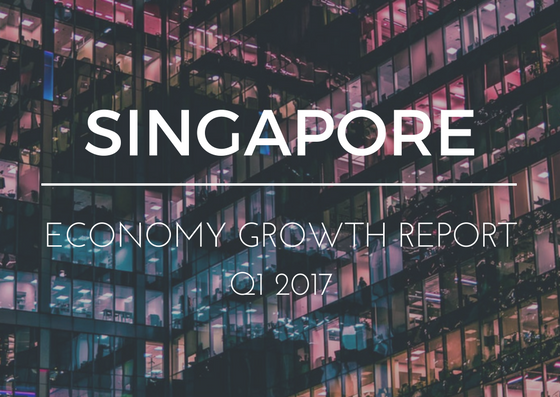
Singapore Economy Growth Report Q1-17
The Ministry of Trade and Industry is releasing its semi-annual monetary policy statement and flash data for GDP Q1 2017 next Thursday (13th April). The Singapore economy grew 2.9% in Q4 2016, bringing full-year growth in 2016 to 2%. Stronger-than-expected rebound in export and manufacturing have led to expectations of an increase in economic growth in 2017 from 1.5% to 2.3% in the Singapore economy.
Manufacturing
According to the Singapore Economy Growth report, the Purchasing Managers’ Index (PMI) has been increasing for the past seven months, indicating an expansion in the manufacturing industry. Strong global demand for electronics, particularly semiconductor is one of the reason for the rise in PMI. Similar trends have been pick up globally, and in regional countries such as Vietnam, Philippines, Indian and Indonesia, as reflected by the Asean Manufacturing PMI. This is attributed by an improvement in domestic and export orders, as well as higher inventory and employment.
Purchasing Managers’ Index: an indication of the manufacturing sector’s economic health. The objective of PMI is to provide current business information of the manufacturing industry to various parties, and is based on five major indicators; employment environment, supplier deliveries, production, new orders and inventory levels.
Construction
On the contrary, according to the Singapore Economy Growth report, the construction industry is experiencing long payment delays. According to a report by the Singapore Commercial Credit Bureau (SCCB), prompt payments (90% of total bills paid within agreed payment terms) account for less than 50% of all payment transactions. 40% of all payment transactions are considered as slow payments (50% of total bills paid after agreed credit terms).
Private Sector
Growth in the private sector is attributed by an anticipation of higher demands. Companies are stocking up preproduction stocks, increasing staff members, experiencing stronger expansions in output and new orders. Export sales are also increasing to a positive value. These indications are building up business confidence as companies continuing hiring and stock building. However, companies are also facing increasing cost issues, such as wage inflation. These are reflected in the increase in prices for goods and services in the Singapore economy, suggesting a squeeze in profit margin.
Coping with Singapore Economy Growth
If you are a Singapore SME facing pressure from an increasing cost, InvoiceInterchange stands ready to help SMEs tackle the challenges by providing a low cost of financing through invoice trading. These capital locked in the supply chain can be utilized to develop and integrate technology into the business, mitigate operational cost and even finance the cost required for venturing into new markets. Free up the locked cash by invoice trading to obtain payment much earlier now!
Related Articles
2017 Singapore Budget, what it means to you
2016 APAC Payment status report
References
Investopedia. (n.d.). Purchasing Managers’ Index – PMI. Retrieved from Investopedia : http://www.investopedia.com/terms/p/pmi.asp
Min, C. Y. (2017, 4 4). Manufacturing marches up for seventh straight month. Retrieved from Straits Times: http://www.straitstimes.com/business/economy/manufacturing-marches-up-for-seventh-straight-month
Williams, A. (2017, 4 4). Payment delays by construction firms hit record high in Q1, overall picture mixed. Retrieved from Straits Times: http://www.straitstimes.com/business/economy/payment-delays-by-construction-firms-hit-record-high-in-q1-overall-picture-mixed
Williams, A. (2017, 4 5). Singapore private sector growth picks up in March to four-month high. Retrieved from Straits Times: http://www.straitstimes.com/business/economy/singapore-private-sector-growth-picks-up-in-march-to-four-month-high
Williams, A. (2017, 4 6). Singapore to release monetary policy statement, advance Q1 GDP data on April 13. Retrieved from Straits Times: http://www.straitstimes.com/business/economy/singapore-to-release-monetary-policy-statement-advance-q1-gdp-data-on-april-13
Related Articles

Boosting Your Business: Top Strategies for Improving Cash Flow

The Ultimate Guide to Receivables Financing: Boosting Your Business Cash Flow
